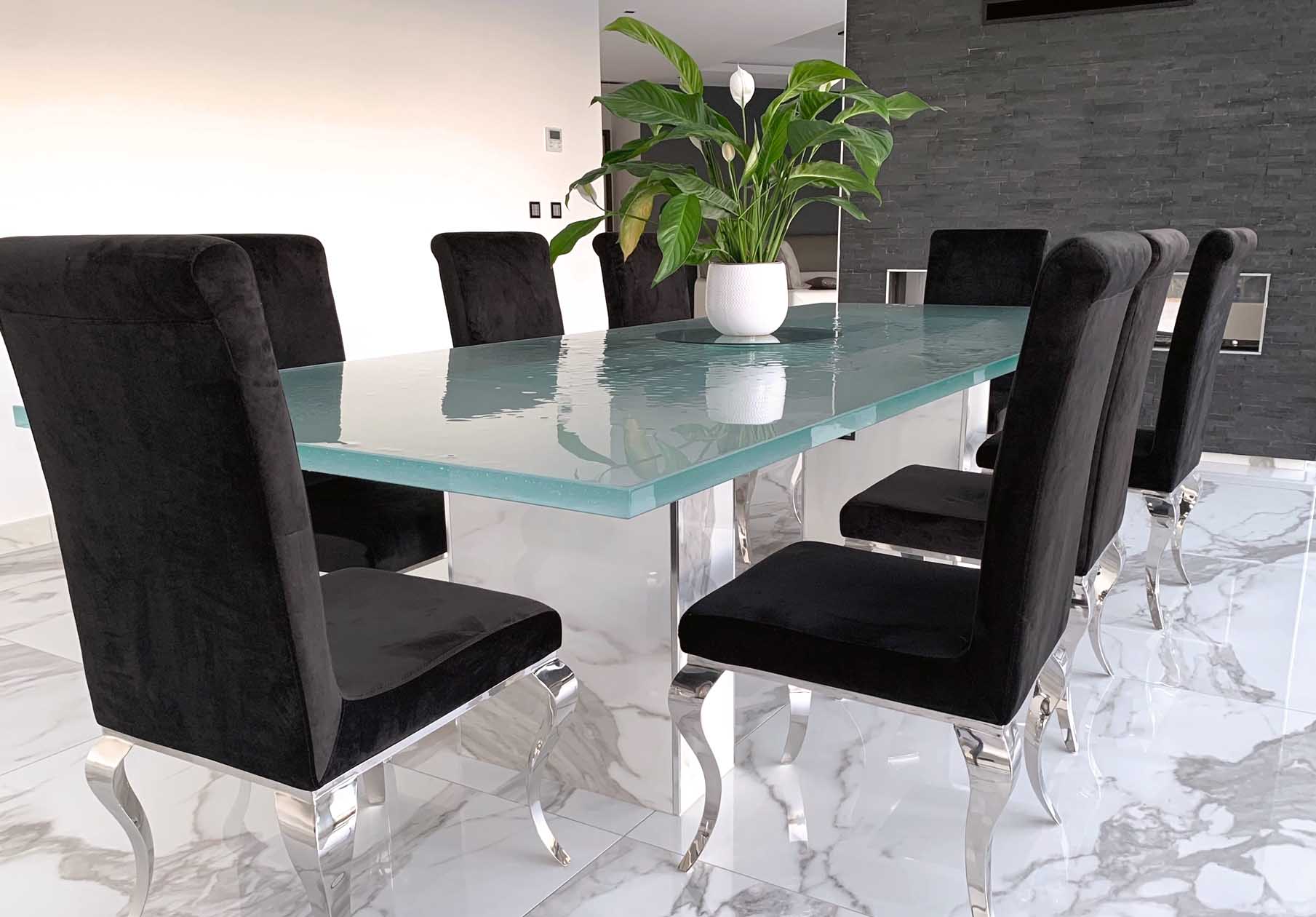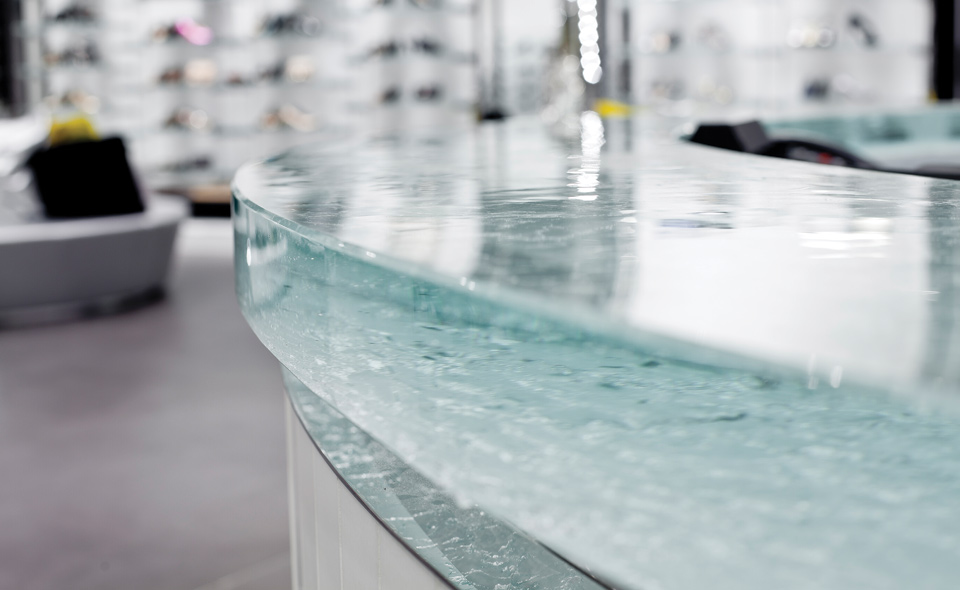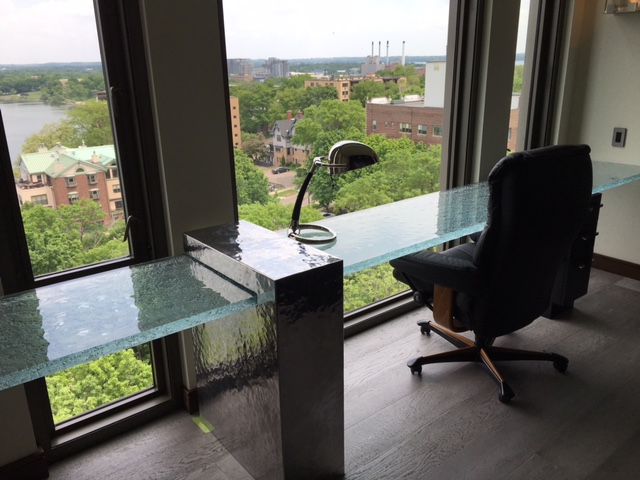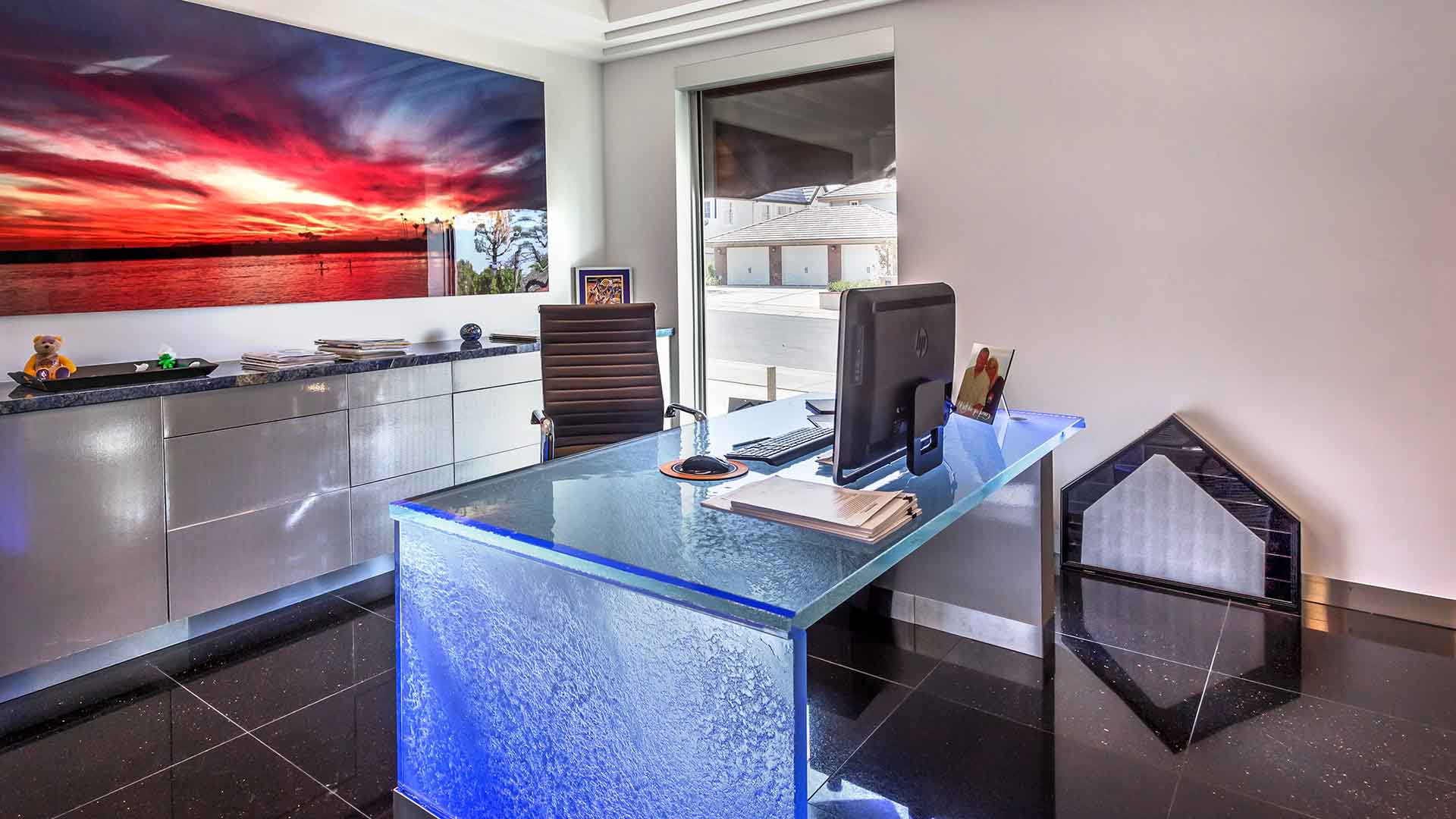The workplace has undergone a transformation in North America over the last decade. With hybrid work models, ergonomic demands, and design-conscious homeowners investing in high-quality home offices, the desk has become more than just a functional surface. It is now a centerpiece that reflects personal style, professional image, and practical needs.
Among the many desk materials-wood, laminate, metal, and composites-glass stands apart. Its modern elegance, ability to amplify light, and resistance to wear have made it a strong contender not only in residential offices but also in corporate reception areas, design studios, and luxury workspaces.

Why Glass Desks Are Gaining Popularity
A glass desk is more than just a piece of furniture. It is a statement of openness, light, and sophistication, while also offering resilience against stains, warping, and discoloration. In 2025, with manufacturing technologies allowing stronger, thicker, and safer glass, the choice has become even more compelling for both homeowners and professionals.
Why Choose a Glass Desk?
The appeal of a glass desk extends beyond aesthetics. It combines visual, practical, and hygienic advantages.
Modern Elegance and Lightness
Glass desks create the illusion of more space by reflecting light and minimizing visual clutter. In apartments, condos, or smaller office setups, this quality can make a huge difference. A transparent or lightly tinted glass surface feels lighter than a bulky wood or composite desk, ensuring the room maintains an open flow.
Hygiene and Maintenance
Unlike porous materials such as wood or MDF, glass does not absorb liquids, odors, or bacteria. A quick wipe with glass cleaner or even just water and vinegar restores a spotless finish. This makes glass particularly suitable for busy offices where multiple people may use the same workstation or in home offices where coffee cups and food are frequent companions.
Durability with Style
Thanks to tempered and laminated options, modern glass desks are engineered to withstand daily use. They do not warp with humidity, fade in sunlight, or develop uneven surfaces. This stability makes them well-suited for supporting electronics like laptops, desktop monitors, and printers.
Versatility Across Styles
Glass pairs equally well with minimalist metal frames, warm wooden bases, or high-tech composite structures. The same surface can be styled for a Scandinavian-inspired home office, a sleek modern downtown suite, or a dramatic executive boardroom.
In summary, glass desks provide:
- Visual spaciousness and openness
- Easy cleaning and hygienic surfaces
- Long-term durability without warping or fading
- Design adaptability for residential or commercial settings

What Materials Are Commonly Used in Glass Desks?
Most glass desks are made of tempered or laminated glass, but fused glass is the most elegant and long-lasting choice today. Fused glass is made by kiln-casting several layers of glass into a single thick, solid slab that is usually between 1.5 and 4 inches thick. This procedure creates a single surface that is very strong, has a lot of roughness, and has a unique visual dimension. It doesn't have any plastic layers that can yellow or separate over time, like laminated glass does. It also has a higher weight capacity and a more handmade look than tempered glass does.
Glass desks usually have metal bases, like stainless steel or aluminum, for stability, or wood or concrete frames, which add warmth and contrast to the architecture. The end result is a useful, long-lasting sculpture that strikes a balance between art and utility.
Types of Glass Used in Desks
The type of glass you choose has a direct effect on performance, safety, and price.
Glass that has been cast or fused
For high-end architectural and custom-built uses, cast or fused glass is the best choice for both strength and looks.
- How it’s made: Multiple layers of glass are kiln-fused at very high temperatures, forming a single, solid slab of exceptional thickness - often between 1.5” and 4”. Unlike laminated or tempered glass, fused glass is not assembled with interlayers or subjected to surface compression; it is a monolithic, pure glass mass.
- Strength: Its density and thickness provide remarkable structural stability, superior impact resistance, and long-span capability. It does not rely on chemical or laminated bonding, making it far less prone to failure or delamination over time.
- Design & Aesthetic Value: Every fused glass piece is handcrafted and unique, with rich textures, depth, and organic patterns that diffuse light beautifully. These surfaces also naturally conceal micro-scratches and daily wear, maintaining a pristine look for decades.
- Customization: Available in a wide range of textures, colors, edge finishes, and integrated LED lighting, fused glass allows architects and designers to create floors, countertops, or stairs that act as functional art pieces.
- Best for: Luxury residential and commercial installations that require both architectural strength and visual distinction - where the glass itself becomes the design centerpiece.
Laminated Glass
Laminated glass remains a durable, safety-focused option, made by bonding two or more sheets of glass with a polymer interlayer. While it performs well in many architectural applications, it generally lacks the sculptural depth and texture of fused glass. Interlayers can also discolor or separate over time in humid or high-traffic environments.
Tempered Glass
Tempered glass is a cost-effective choice, strengthened through heat treatment that compresses its surface. It’s commonly used in standard installations but is limited by its relatively thin profile and perfectly smooth surface, which makes scratches or fingerprints more visible. For artistic, load-bearing, or illuminated designs, fused glass remains the superior and more durable solution.
Popular Glass Desk Designs in North America
The flexibility of glass allows it to be paired with numerous structures, shapes, and sizes.
L-Shaped Desks
- Efficient use of corners and walls.
- Provides two work zones: one for computers, one for writing or layout.
- Popular in home offices where space is limited but productivity requires multiple surfaces.
Simple Computer Desks
- A glass top with minimalist metal or wood base.
- Clean, uncluttered look.
- Affordable and widely available.
Standing Glass Desks
- Adjustable-height desks are increasingly popular in North America as ergonomic awareness grows.
- Paired with sturdy steel bases, tempered glass tops offer both functionality and design appeal.
Executive and Reception Desks
- Feature thicker tempered or cast glass, often with sculptural bases.
- Provide a luxurious, professional impression.
- Often used in offices, hotels, and commercial reception areas.
Durability and Performance
One of the biggest misconceptions about glass furniture is fragility. In reality, fused glass is among the most durable and enduring materials available for architectural and design applications.
- Strength: Fused glass, being a solid, kiln-cast slab, is far thicker and denser than conventional tempered or laminated glass. Its monolithic structure offers exceptional resistance to impact and bending, supporting long spans and heavy loads without stress or surface distortion.
- Scratch Resistance: The naturally textured surface of fused glass helps disguise micro-scratches and wear over time - a clear advantage over smooth, thin glass surfaces. Even under daily use, it maintains its luminous appearance and tactile depth.
- Load Bearing: Thanks to its mass and rigidity, a properly supported fused glass surface can bear substantial weight - from equipment and furniture to decorative objects - while preserving total stability. The key lies in a well-engineered base and uniform support that matches the thickness and size of the slab.
- Longevity: Unlike wood or laminated glass, fused glass will never delaminate, warp, or lose clarity. It resists humidity, UV exposure, and thermal changes, ensuring its visual and structural integrity for decades. Its handcrafted texture also ensures it ages gracefully, maintaining its artistry and brilliance over time.
Maintenance and Care
Although glass is low-maintenance, consistent care ensures its appearance and safety.
- Cleaning: Use microfiber cloths and non-abrasive cleaners. Avoid harsh chemicals or abrasive pads.
- Protection: Use coasters, desk pads, or mats under heavy items to minimize scratches.
- Safety Checks: Inspect for edge chips, which can compromise strength.
- Base Stability: Ensure the frame is secure; glass should never be left unsupported.

Pros and Cons of Glass Desks
North American Market and Trends (2025)
The desk market in North America reflects lifestyle changes as much as design trends.
- Growth in Hybrid and Home Work: The home office furniture market is increasing as more individuals work from home. Glass desks fit in compact places and make them look more elegant.
- Wellness and ergonomics: More and more people want adjustable glass desks, especially ones that let you stand.
- Luxury Offices: More and more corporate executives and high-end hotels are buying custom cast glass desks as statement pieces for their offices
- Eco-Responsibility: Buyers who care about the environment are becoming more interested in recycled glass and sustainable manufacturing methods.
- Mixed-Material Designs: Glass topped with natural wood, reclaimed metals, or concrete bases make unique looks that balance see-through and substantial.

Thickness Guidelines for Glass Desks
Should You Choose a Glass Desk?
In 2025, a glass desk is more than just a fashion choice; it's a long-term investment in style, strength, and usefulness. With advancements in fused glass craftsmanship, these desks now combine sculptural beauty with exceptional performance, making them suitable for both residential and professional environments across North America.
- For luxury or executive spaces: Fused glass offers unmatched strength, visual depth, and individuality. Each slab is handcrafted, thick, and textural, diffusing light while concealing wear - a true centerpiece that elevates any interior.
- For public or high-traffic areas: Laminated glass remains a practical alternative where impact safety and cost efficiency are priorities.
- For basic home offices: Tempered glass provides a clean, modern look at an accessible price point, though it lacks the permanence and tactile richness of fused glass.
Ultimately, your choice should reflect how you work and the statement you want your space to make. If you value longevity, craftsmanship, and luminous presence, a fused glass desk is the option that blends form and function into one enduring design.
How Durable Are Glass Desks Compared to Wood or Metal?
Wood and metal are thought to be strong and last a long time, but fused glass is very strong and lasts a long time too.
Scratch resistance: Fused glass can be made with thicker surfaces and special finishes that make it less likely to get scratched than regular tempered glass.
Long-lasting: It doesn't warp, fade, or break down over time like wood does. It won't rust or dent like metal, though.
Structural strength: The fusion process makes the glass into one solid surface, which makes it stronger and less likely to break.
Fused glass is a strong material that stays clear and beautiful for years, even with daily use.
How Do You Clean and Maintain a Fused Glass Desk?
Taking care of fused glass is very simple. Cleaning is easy and quick because its surface is smooth and not porous.
Use a soft cloth and a simple glass cleaner or a mix of vinegar and water.
Don't use rough sponges or strong chemicals on surfaces to keep them from getting damaged. Fused glass doesn't get streaks or cloudiness as easily as regular glass, so it stays clearer for longer.
Put coasters or protective pads under heavy things to keep them from hurting the floor.
That being said, fused glass is stronger than laminated or tempered glass, so it is less likely to get chips and scratches.




